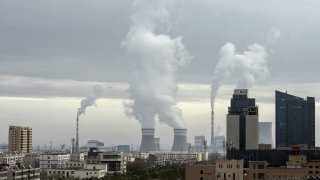
- "Absent significant changes in policy or technology," global energy consumption will grow by almost 50% between 2020 and 2050, according to a new report released Wednesday from the U.S. Energy Information Administration.
- Energy-related carbon dioxide emissions will also increase through 2050 due to economic and population growth, the report finds.
- The number of internal combustion engine cars is expected to peak in 2023 in Organization for Economic Cooperation and Development (OECD) countries. Globally, the internal combustion engine market is expected to peak in 2038.
Even with the current drive toward more renewable energy sources, global carbon emissions are going to increase through 2050, unless there are significant changes in policy or technology between now and then.
That's according to a new report released Wednesday from the U.S. Energy Information Administration, a division of the federal U.S. Department of Energy which analyzes and shares data. For the report, the EIA projects future energy trends based on current laws and regulations. This assumption, and the resulting findings, emphasize the need for governmental changes and new technology to reduce the carbon dioxide emissions that cause climate change.
"Even with growth in renewable energy, without significant policy changes or technological breakthroughs, we project increasing energy-related carbon dioxide emissions through 2050," said Stephen Nalley, the Acting Administrator of the EIA, in a written statement.
Get San Diego local news, weather forecasts, sports and lifestyle stories to your inbox. Sign up for NBC San Diego newsletters.
Assuming current trajectories, economic and population growth will drive a 50% increase in global energy consumption between 2020 and 2050.
Renewable energy, such as wind and solar, will see the largest growth among energy sources through 2050, the report says.
Money Report
"The worldwide push to generate more electricity from renewables and also increase electric grid reliability could push more expansion of battery storage on a global scale," Nalley said.
But even though renewables will grow fastest, liquid fuels will be the still be the primary source of energy, primarily because of the transportation and industrial sectors. (Liquid fuels refers to all petroleum, including crude oil and products of petroleum refining, natural gas liquids, biofuels, and liquids derived from other hydrocarbon sources, including coal to liquids and gas to liquids. Here, liquid fuels does not include liquefied natural gas and liquid hydrogen.)
Oil and natural gas production will increase overall to meet demand in developing economies in Asia.
"The fast-growing economies in Asia could combine to become the largest importer of natural gas and crude oil by 2050, given their significant increase in energy consumption," Nalley said.
Demand for and consumption of energy in non-OECD countries in Asia will be more than those countries are able to produce. That will drive an increase in the import of crude oil and finished petroleum products from the Middle East, the EIA says.
Non-OECD countries in Asia will be the largest importers of natural gas, the report says, while Russia will be the largest exporter of natural gas.
Also mentioned in the report, sales of electric vehicles are expected to grow through 2050, and the number of internal combustion engine cars is expected to peak in 2023 in OECD countries. Globally, the internal combustion engine market is expected to peak in 2038.






